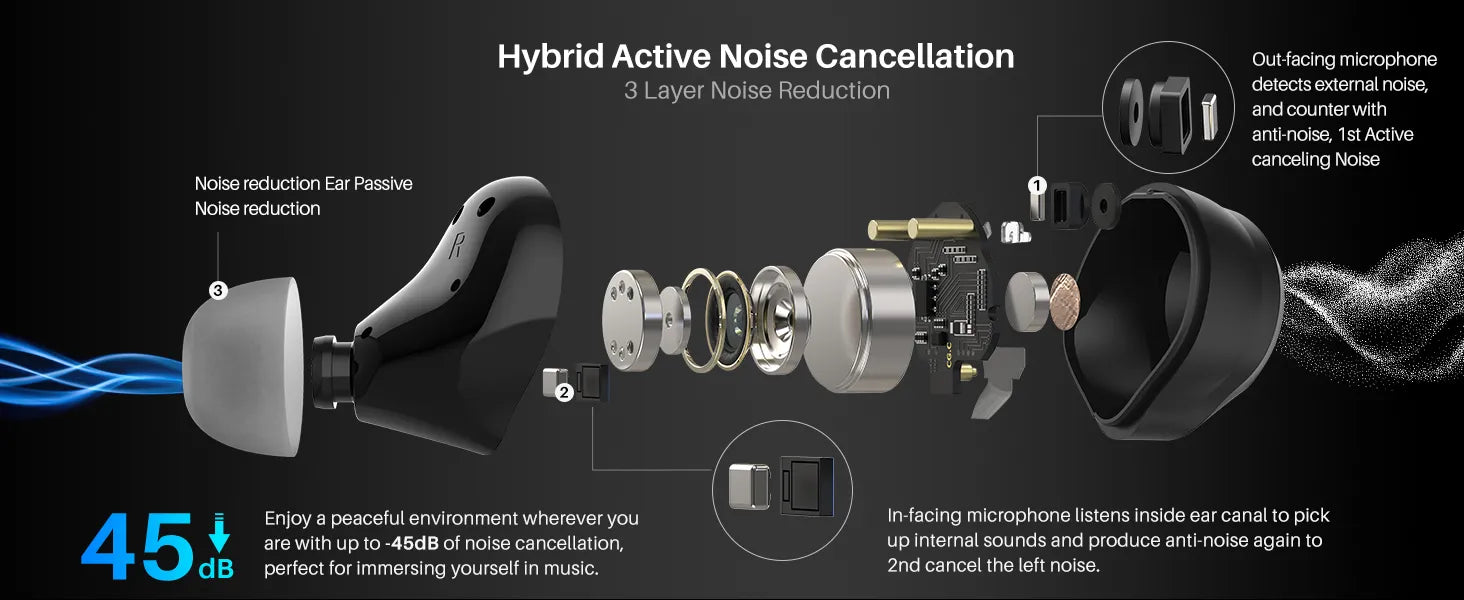Traveling by airplane or train surrounds you with a constant layer of noise. Engines hum, wheels grind, and conversations blend into a steady background buzz that can feel overwhelming. Wireless earbuds help soften this chaos, giving you a small bubble of calm even in crowded cabins. They make it easier to focus on music, movies, or simply relax during long hours on the move. This guide walks through practical ways to use your wireless earbuds more effectively during travel, so your journey feels smoother, quieter, and more comfortable from start to finish.

Choosing the Right Noise Cancellation Wireless Earbuds
Finding earbuds suited for airplanes and trains makes a huge difference in how enjoyable your trip feels. Some models block sound through physical design, while others use advanced audio processing to counter outside noise. Understanding these differences helps you choose the right pair for your travel style.
Active Noise Cancellation vs Passive Isolation
Passive isolation relies on a tight seal to block noise naturally. It works well for higher-frequency sounds, such as chatter or clattering luggage. Active Noise Cancellation, however, targets low rumbling noises that dominate airplanes and trains. It detects unwanted sound and cancels it with an opposite wave, making the cabin feel far quieter. When both methods work together, you get a richer, more peaceful listening experience without turning the volume too high.
How Adaptive Noise Cancellation Stands Out
Adaptive Noise Cancellation adjusts itself based on your surroundings. This is useful when noise levels constantly shift, like during takeoff, tunnels, or busy train stations. The earbuds sense these changes and tune the cancellation level automatically. You get smoother transitions and more consistent quiet without needing to switch modes manually. This feature keeps you comfortable throughout the entire journey, even when the environment becomes unpredictable.
Battery Management of Wireless Earbuds on Long Trips
Long trips require careful battery planning. Airplanes and trains offer extended hours of travel, and the last thing you want is your earbuds dying mid-journey. Managing your earbud power helps you stay entertained without interruptions.
Estimating Battery Life for Multi-Hour Travel
Before boarding, check the estimated battery life of your earbuds with ANC on. Many models list separate runtimes for ANC and non-ANC modes. Plan based on the longest stretches of travel you expect. If your earbuds support quick charging, plug them in for a short burst before boarding. Even a few minutes can give enough power for several hours of use. This small step helps prevent sudden audio drop-offs during movies or music sessions.
Using Charging Cases Efficiently
The charging case is your best friend on long trips. Keep it fully charged and store your earbuds inside it whenever you take a break. Each short rest period adds a little extra power. This approach stretches your total usage time significantly. If you carry a power bank, you can recharge the case during layovers or long train stops. Smart case usage keeps your earbuds running smoothly all day.
Managing Ear Health While Using Wireless Earbuds
Extended listening sessions can strain your ears, especially in loud environments. Airplanes also add pressure changes, making your ears feel clogged or uncomfortable. Taking simple steps to care for your ears helps prevent fatigue and irritation.

Taking Listening Breaks
Your ears need occasional rest, just like your eyes do. Taking short breaks every hour reduces strain and helps maintain comfort. During breaks, store your earbuds in the case to conserve battery and avoid losing them. Pausing from constant sound also helps reduce fatigue, making the rest of your journey more pleasant.
Preventing Ear Pressure and Discomfort
Airplane cabins often cause pressure changes that your ears must adjust to. Chewing gum, swallowing, or performing gentle yawns helps regulate pressure. Choose ear tips that fit snugly but comfortably. Soft silicone or memory foam tips can help reduce discomfort during long wear. Managing pressure well keeps travel more comfortable and your listening experience more enjoyable.
TOZO NC9: Best Wireless Earbuds for Airplanes and Trains
The TOZO NC9 delivers a balanced mix of comfort, strong noise reduction, and reliable battery life, making it a solid travel-friendly choice. It helps quiet down the loud hum of airplanes and trains, letting you enjoy music, movies, or podcasts without distractions. Its ergonomic design and lightweight build make it ideal for long sessions. With dependable performance and a smooth listening experience, the NC9 suits travelers who want peace and convenience on every trip.
Excellent Noise Cancellation Performance
The NC9 offers effective Hybrid Active Noise Cancellation that offers up to 45 dB of noise reduction depth. This makes audio clearer and reduces the need for high volume in loud environments. The earbuds maintain consistent noise reduction performance throughout different stages of travel, helping you stay focused and relaxed during long journeys.

Ergonomic Design for Extended Comfort
Comfort matters when you are sitting for hours. The NC9 is shaped to fit comfortably in the ear without creating pressure points. Its lightweight build allows you to wear it for extended periods. Combined with soft ear tips that form a gentle seal, it offers a secure and pleasant fit that stays comfortable from departure to arrival.
Ultra-Long Battery Life
The NC9 provides long-lasting battery life that supports full-day travel. With the charging case, you can keep your earbuds powered for 59 hours of playtime. The battery is efficient enough to handle extended use with ANC on, offering up to 42 hours of total listening time even in maximum ANC.
Conclusion
Wireless earbuds can make long trips feel calmer, clearer, and more enjoyable. With strong noise cancellation, a comfortable fit, and thoughtful battery management, travel becomes much smoother. The TOZO NC9 offers reliable performance for busy travelers who want peace and comfort on airplanes and trains.






























